Employment Law: UK Regulations, Rights and Legal Procedures, Report
VerifiedAdded on 2021/02/22
|19
|6250
|177
Report
AI Summary
This report offers a comprehensive overview of UK employment law, encompassing various crucial aspects. It begins by defining the aims and objectives of employment regulation, emphasizing the role of tribunals and courts in enforcement, and detailing case settlement procedures. The report then delves into the recruitment and selection process, highlighting discrimination laws and the establishment of employment contracts. Further, it explores how contracts can be lawfully altered, the requirements of redundancy and business transfer laws, and the statutory rights of workers, including pay, leave, and working time. It also covers equal pay, family-friendly rights, health and safety regulations, implied duties, and freedom of association. The report concludes with a discussion of disciplinary situations, specifically unfair dismissal related to capability and misconduct, and the right to accompaniment during disciplinary hearings.

EMPLOYMENT LAW
Paraphrase This Document
Need a fresh take? Get an instant paraphrase of this document with our AI Paraphraser
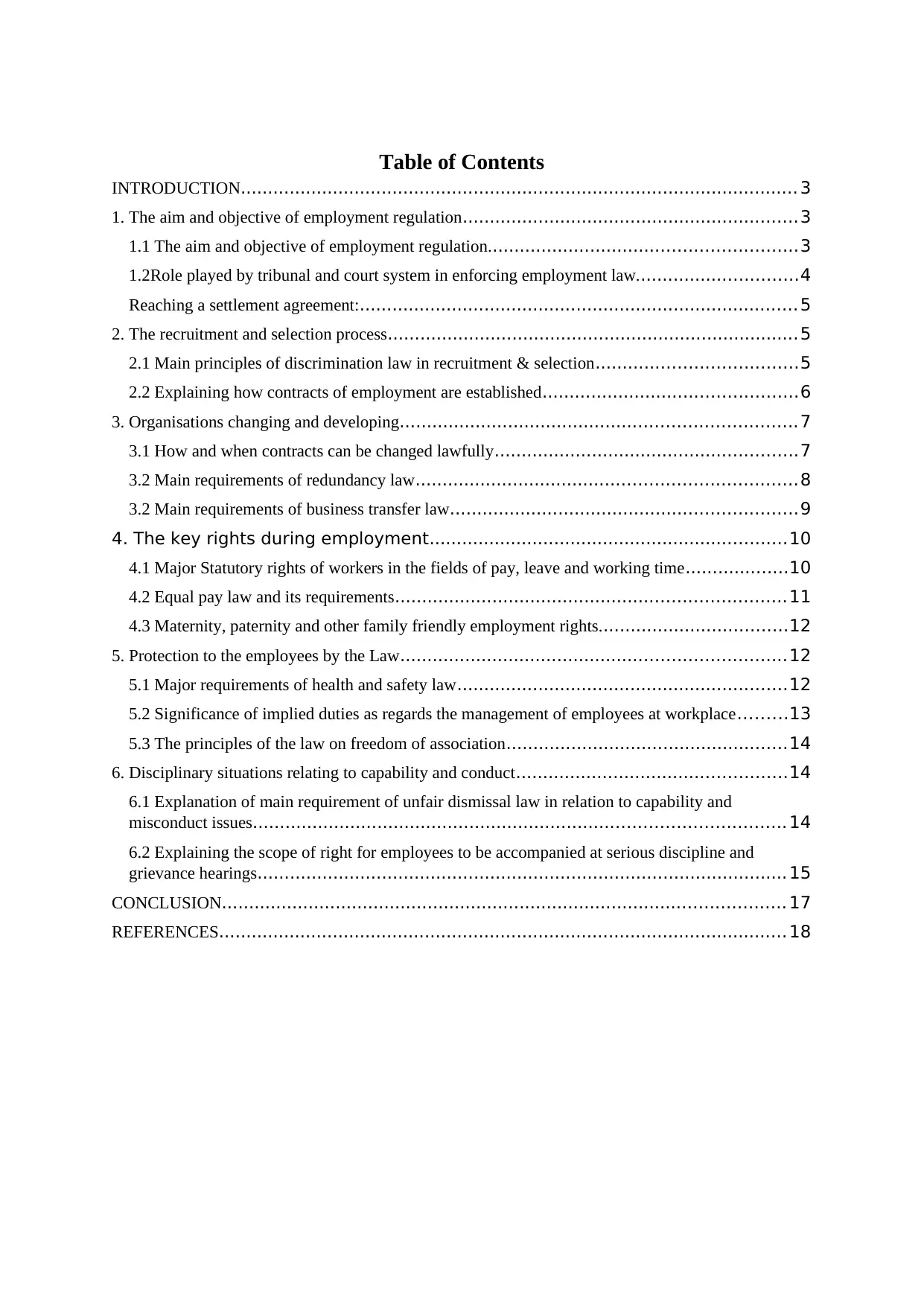
Table of Contents
INTRODUCTION....................................................................................................... 3
1. The aim and objective of employment regulation..............................................................3
1.1 The aim and objective of employment regulation.........................................................3
1.2Role played by tribunal and court system in enforcing employment law..............................4
Reaching a settlement agreement:................................................................................. 5
2. The recruitment and selection process............................................................................5
2.1 Main principles of discrimination law in recruitment & selection.....................................5
2.2 Explaining how contracts of employment are established...............................................6
3. Organisations changing and developing.........................................................................7
3.1 How and when contracts can be changed lawfully........................................................7
3.2 Main requirements of redundancy law......................................................................8
3.2 Main requirements of business transfer law................................................................9
4. The key rights during employment..................................................................10
4.1 Major Statutory rights of workers in the fields of pay, leave and working time...................10
4.2 Equal pay law and its requirements........................................................................11
4.3 Maternity, paternity and other family friendly employment rights...................................12
5. Protection to the employees by the Law.......................................................................12
5.1 Major requirements of health and safety law.............................................................12
5.2 Significance of implied duties as regards the management of employees at workplace.........13
5.3 The principles of the law on freedom of association....................................................14
6. Disciplinary situations relating to capability and conduct..................................................14
6.1 Explanation of main requirement of unfair dismissal law in relation to capability and
misconduct issues.................................................................................................. 14
6.2 Explaining the scope of right for employees to be accompanied at serious discipline and
grievance hearings.................................................................................................. 15
CONCLUSION........................................................................................................ 17
REFERENCES......................................................................................................... 18
INTRODUCTION....................................................................................................... 3
1. The aim and objective of employment regulation..............................................................3
1.1 The aim and objective of employment regulation.........................................................3
1.2Role played by tribunal and court system in enforcing employment law..............................4
Reaching a settlement agreement:................................................................................. 5
2. The recruitment and selection process............................................................................5
2.1 Main principles of discrimination law in recruitment & selection.....................................5
2.2 Explaining how contracts of employment are established...............................................6
3. Organisations changing and developing.........................................................................7
3.1 How and when contracts can be changed lawfully........................................................7
3.2 Main requirements of redundancy law......................................................................8
3.2 Main requirements of business transfer law................................................................9
4. The key rights during employment..................................................................10
4.1 Major Statutory rights of workers in the fields of pay, leave and working time...................10
4.2 Equal pay law and its requirements........................................................................11
4.3 Maternity, paternity and other family friendly employment rights...................................12
5. Protection to the employees by the Law.......................................................................12
5.1 Major requirements of health and safety law.............................................................12
5.2 Significance of implied duties as regards the management of employees at workplace.........13
5.3 The principles of the law on freedom of association....................................................14
6. Disciplinary situations relating to capability and conduct..................................................14
6.1 Explanation of main requirement of unfair dismissal law in relation to capability and
misconduct issues.................................................................................................. 14
6.2 Explaining the scope of right for employees to be accompanied at serious discipline and
grievance hearings.................................................................................................. 15
CONCLUSION........................................................................................................ 17
REFERENCES......................................................................................................... 18
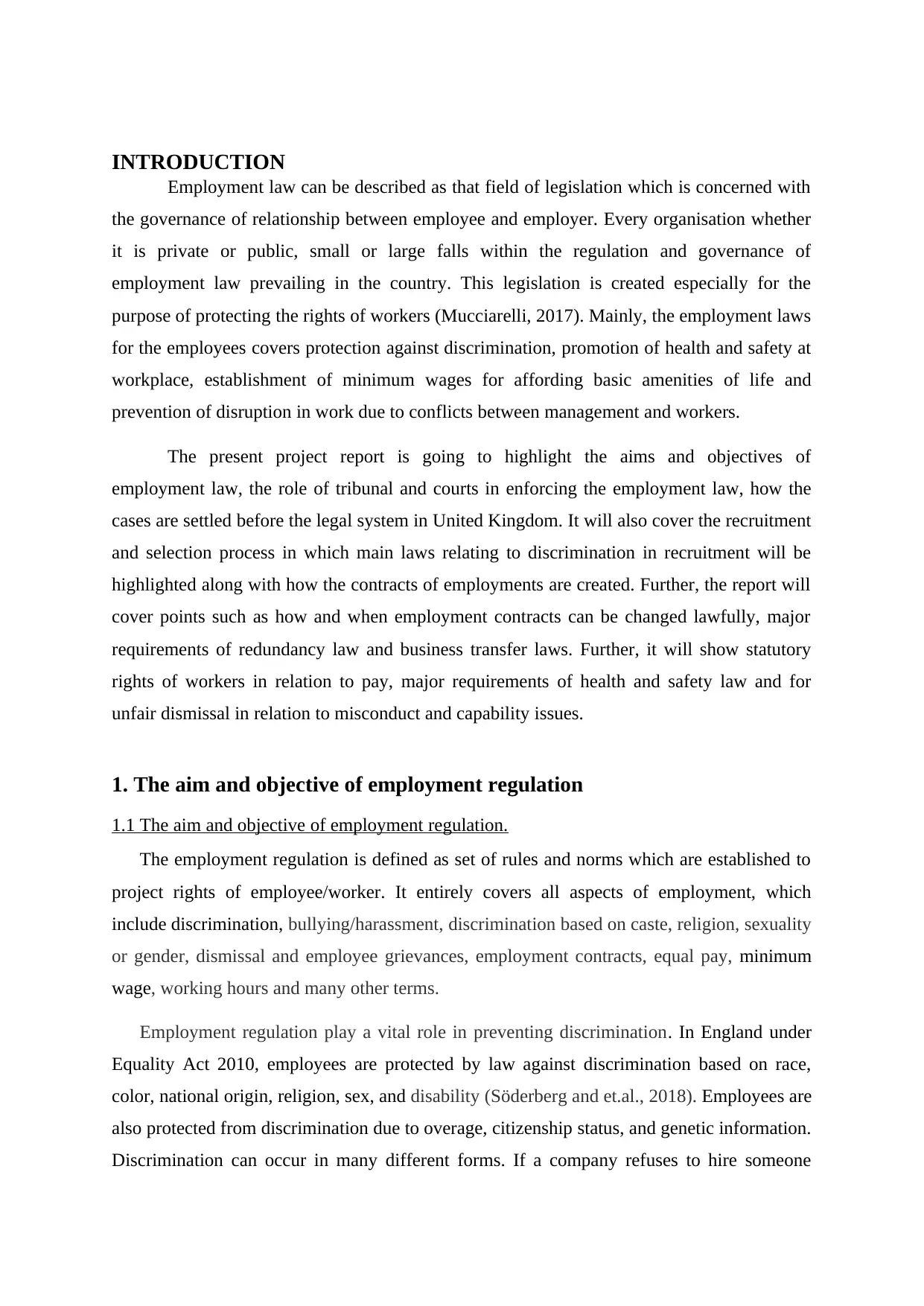
INTRODUCTION
Employment law can be described as that field of legislation which is concerned with
the governance of relationship between employee and employer. Every organisation whether
it is private or public, small or large falls within the regulation and governance of
employment law prevailing in the country. This legislation is created especially for the
purpose of protecting the rights of workers (Mucciarelli, 2017). Mainly, the employment laws
for the employees covers protection against discrimination, promotion of health and safety at
workplace, establishment of minimum wages for affording basic amenities of life and
prevention of disruption in work due to conflicts between management and workers.
The present project report is going to highlight the aims and objectives of
employment law, the role of tribunal and courts in enforcing the employment law, how the
cases are settled before the legal system in United Kingdom. It will also cover the recruitment
and selection process in which main laws relating to discrimination in recruitment will be
highlighted along with how the contracts of employments are created. Further, the report will
cover points such as how and when employment contracts can be changed lawfully, major
requirements of redundancy law and business transfer laws. Further, it will show statutory
rights of workers in relation to pay, major requirements of health and safety law and for
unfair dismissal in relation to misconduct and capability issues.
1. The aim and objective of employment regulation
1.1 The aim and objective of employment regulation.
The employment regulation is defined as set of rules and norms which are established to
project rights of employee/worker. It entirely covers all aspects of employment, which
include discrimination, bullying/harassment, discrimination based on caste, religion, sexuality
or gender, dismissal and employee grievances, employment contracts, equal pay, minimum
wage, working hours and many other terms.
Employment regulation play a vital role in preventing discrimination. In England under
Equality Act 2010, employees are protected by law against discrimination based on race,
color, national origin, religion, sex, and disability (Söderberg and et.al., 2018). Employees are
also protected from discrimination due to overage, citizenship status, and genetic information.
Discrimination can occur in many different forms. If a company refuses to hire someone
Employment law can be described as that field of legislation which is concerned with
the governance of relationship between employee and employer. Every organisation whether
it is private or public, small or large falls within the regulation and governance of
employment law prevailing in the country. This legislation is created especially for the
purpose of protecting the rights of workers (Mucciarelli, 2017). Mainly, the employment laws
for the employees covers protection against discrimination, promotion of health and safety at
workplace, establishment of minimum wages for affording basic amenities of life and
prevention of disruption in work due to conflicts between management and workers.
The present project report is going to highlight the aims and objectives of
employment law, the role of tribunal and courts in enforcing the employment law, how the
cases are settled before the legal system in United Kingdom. It will also cover the recruitment
and selection process in which main laws relating to discrimination in recruitment will be
highlighted along with how the contracts of employments are created. Further, the report will
cover points such as how and when employment contracts can be changed lawfully, major
requirements of redundancy law and business transfer laws. Further, it will show statutory
rights of workers in relation to pay, major requirements of health and safety law and for
unfair dismissal in relation to misconduct and capability issues.
1. The aim and objective of employment regulation
1.1 The aim and objective of employment regulation.
The employment regulation is defined as set of rules and norms which are established to
project rights of employee/worker. It entirely covers all aspects of employment, which
include discrimination, bullying/harassment, discrimination based on caste, religion, sexuality
or gender, dismissal and employee grievances, employment contracts, equal pay, minimum
wage, working hours and many other terms.
Employment regulation play a vital role in preventing discrimination. In England under
Equality Act 2010, employees are protected by law against discrimination based on race,
color, national origin, religion, sex, and disability (Söderberg and et.al., 2018). Employees are
also protected from discrimination due to overage, citizenship status, and genetic information.
Discrimination can occur in many different forms. If a company refuses to hire someone
⊘ This is a preview!⊘
Do you want full access?
Subscribe today to unlock all pages.

Trusted by 1+ million students worldwide

because they are over 40 years old, that can be considered as discrimination. If a company
refuses to promote any person based on caste or race, that can be discrimination. If a
company fires a person because they belong or practice any religion, that is discrimination.
Before minimum wage employment laws came into place, it was completely in employers
hands to determine what an employee was paid. During the Depression, many employers
were paying wages that could not support a working man, let alone his family. The low
wages were the reason the first federal minimum wage was set in 1938. Today, the minimum
living wage in UK is £7.83.
1.2Role played by tribunal and court system in enforcing employment law.
The procedure for employment law to resolve disputes are initially heard either in the
County Court, High Court or the Employment Tribunal. Claims that concerns related to
breach of contract, unmeaningful dismissal and applications for injunctions are brought in
the courts. Matter that involves unfair dismissal, any sort of discrimination, unequal pay,
deductions from wages and maternity rights, are heard in the Employment Tribunal
(Lewis, 2019). In other words, claims involving breach of the common law or contract are
brought in the courts and claims involving a breach of a statute are brought in the
Employment Tribunal. An employee does not have to have worked for their employer for
any given length of time before being able to bring a claim for breach of contract. Any
such claim must be brought within three months of the effective date of termination or
within three months from the last date on which the employee attended work. It is to be
noted that the Employment Tribunal is unable to deal with claims concerning:
● personal injury.
● it is mandatory for an employer to provide living accommodation for its employee.
● term relating to copyright, rights in performances, moral and design rights,
registered designs, patents and trademarks.
● the breach of a term imposing an obligation of confidence.
● the breach of a term which is a covenant in restraint of trade.
1.3 Case settlement before and during formal legal procedure.
refuses to promote any person based on caste or race, that can be discrimination. If a
company fires a person because they belong or practice any religion, that is discrimination.
Before minimum wage employment laws came into place, it was completely in employers
hands to determine what an employee was paid. During the Depression, many employers
were paying wages that could not support a working man, let alone his family. The low
wages were the reason the first federal minimum wage was set in 1938. Today, the minimum
living wage in UK is £7.83.
1.2Role played by tribunal and court system in enforcing employment law.
The procedure for employment law to resolve disputes are initially heard either in the
County Court, High Court or the Employment Tribunal. Claims that concerns related to
breach of contract, unmeaningful dismissal and applications for injunctions are brought in
the courts. Matter that involves unfair dismissal, any sort of discrimination, unequal pay,
deductions from wages and maternity rights, are heard in the Employment Tribunal
(Lewis, 2019). In other words, claims involving breach of the common law or contract are
brought in the courts and claims involving a breach of a statute are brought in the
Employment Tribunal. An employee does not have to have worked for their employer for
any given length of time before being able to bring a claim for breach of contract. Any
such claim must be brought within three months of the effective date of termination or
within three months from the last date on which the employee attended work. It is to be
noted that the Employment Tribunal is unable to deal with claims concerning:
● personal injury.
● it is mandatory for an employer to provide living accommodation for its employee.
● term relating to copyright, rights in performances, moral and design rights,
registered designs, patents and trademarks.
● the breach of a term imposing an obligation of confidence.
● the breach of a term which is a covenant in restraint of trade.
1.3 Case settlement before and during formal legal procedure.
Paraphrase This Document
Need a fresh take? Get an instant paraphrase of this document with our AI Paraphraser
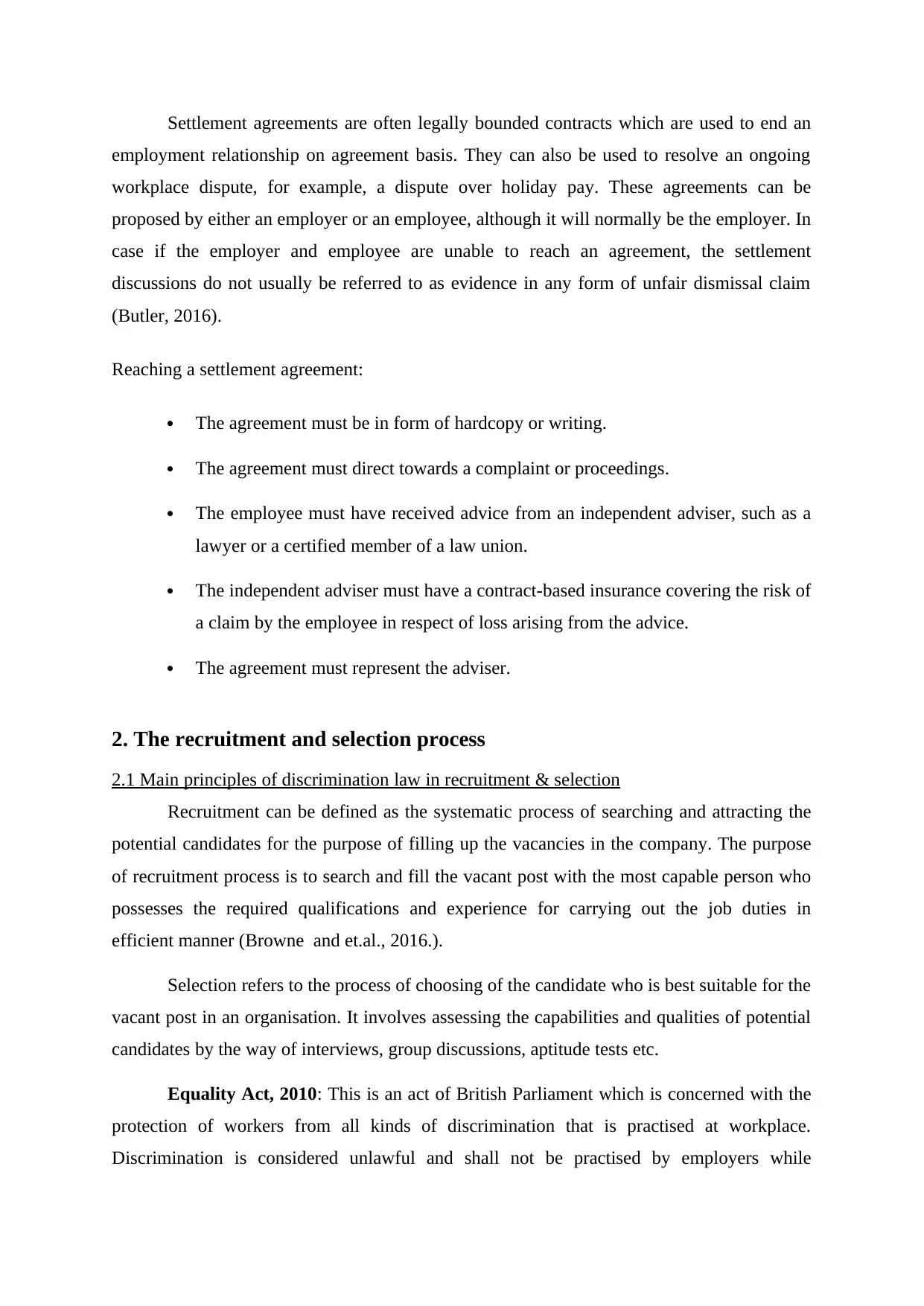
Settlement agreements are often legally bounded contracts which are used to end an
employment relationship on agreement basis. They can also be used to resolve an ongoing
workplace dispute, for example, a dispute over holiday pay. These agreements can be
proposed by either an employer or an employee, although it will normally be the employer. In
case if the employer and employee are unable to reach an agreement, the settlement
discussions do not usually be referred to as evidence in any form of unfair dismissal claim
(Butler, 2016).
Reaching a settlement agreement:
The agreement must be in form of hardcopy or writing.
The agreement must direct towards a complaint or proceedings.
The employee must have received advice from an independent adviser, such as a
lawyer or a certified member of a law union.
The independent adviser must have a contract-based insurance covering the risk of
a claim by the employee in respect of loss arising from the advice.
The agreement must represent the adviser.
2. The recruitment and selection process
2.1 Main principles of discrimination law in recruitment & selection
Recruitment can be defined as the systematic process of searching and attracting the
potential candidates for the purpose of filling up the vacancies in the company. The purpose
of recruitment process is to search and fill the vacant post with the most capable person who
possesses the required qualifications and experience for carrying out the job duties in
efficient manner (Browne and et.al., 2016.).
Selection refers to the process of choosing of the candidate who is best suitable for the
vacant post in an organisation. It involves assessing the capabilities and qualities of potential
candidates by the way of interviews, group discussions, aptitude tests etc.
Equality Act, 2010: This is an act of British Parliament which is concerned with the
protection of workers from all kinds of discrimination that is practised at workplace.
Discrimination is considered unlawful and shall not be practised by employers while
employment relationship on agreement basis. They can also be used to resolve an ongoing
workplace dispute, for example, a dispute over holiday pay. These agreements can be
proposed by either an employer or an employee, although it will normally be the employer. In
case if the employer and employee are unable to reach an agreement, the settlement
discussions do not usually be referred to as evidence in any form of unfair dismissal claim
(Butler, 2016).
Reaching a settlement agreement:
The agreement must be in form of hardcopy or writing.
The agreement must direct towards a complaint or proceedings.
The employee must have received advice from an independent adviser, such as a
lawyer or a certified member of a law union.
The independent adviser must have a contract-based insurance covering the risk of
a claim by the employee in respect of loss arising from the advice.
The agreement must represent the adviser.
2. The recruitment and selection process
2.1 Main principles of discrimination law in recruitment & selection
Recruitment can be defined as the systematic process of searching and attracting the
potential candidates for the purpose of filling up the vacancies in the company. The purpose
of recruitment process is to search and fill the vacant post with the most capable person who
possesses the required qualifications and experience for carrying out the job duties in
efficient manner (Browne and et.al., 2016.).
Selection refers to the process of choosing of the candidate who is best suitable for the
vacant post in an organisation. It involves assessing the capabilities and qualities of potential
candidates by the way of interviews, group discussions, aptitude tests etc.
Equality Act, 2010: This is an act of British Parliament which is concerned with the
protection of workers from all kinds of discrimination that is practised at workplace.
Discrimination is considered unlawful and shall not be practised by employers while
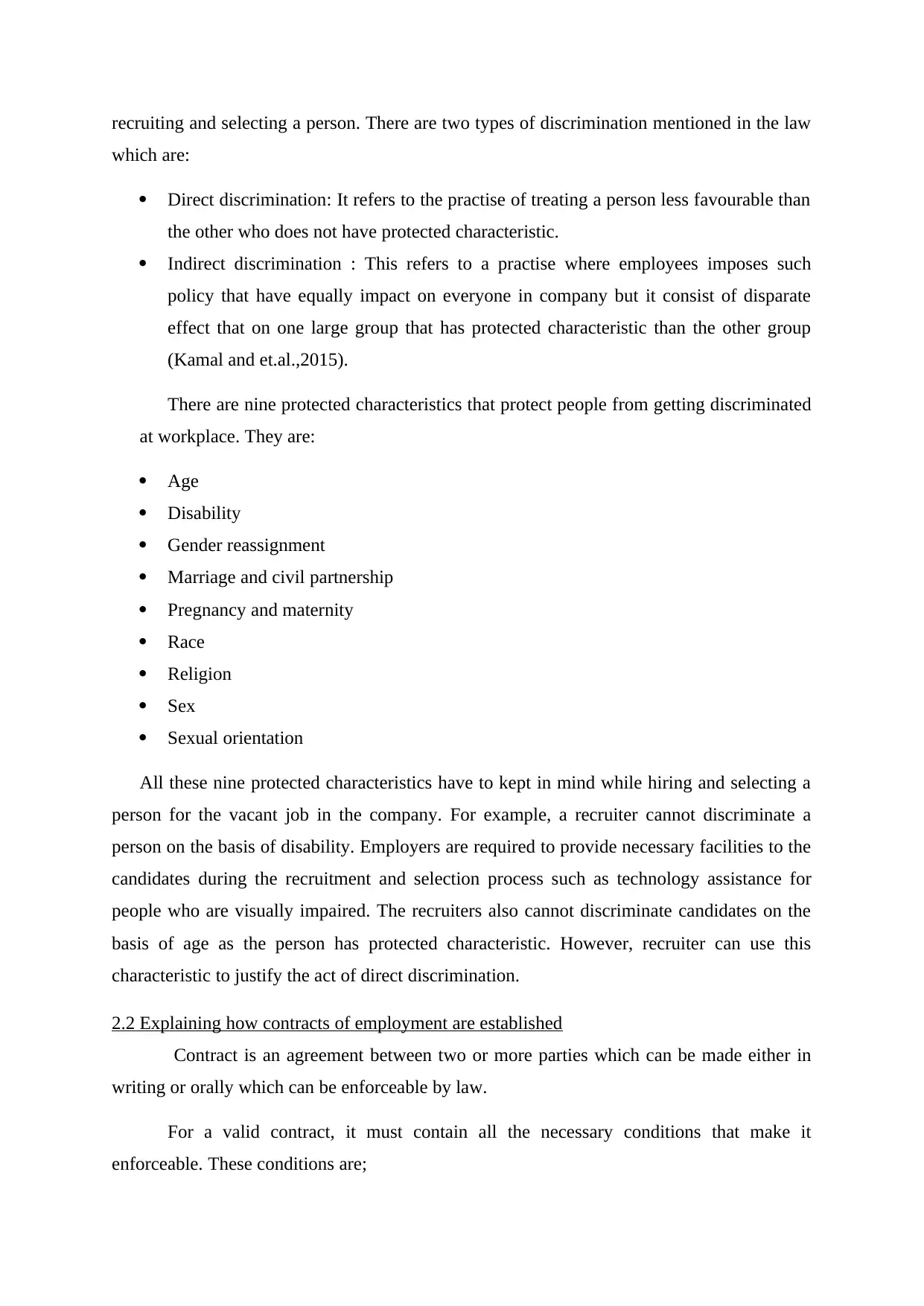
recruiting and selecting a person. There are two types of discrimination mentioned in the law
which are:
Direct discrimination: It refers to the practise of treating a person less favourable than
the other who does not have protected characteristic.
Indirect discrimination : This refers to a practise where employees imposes such
policy that have equally impact on everyone in company but it consist of disparate
effect that on one large group that has protected characteristic than the other group
(Kamal and et.al.,2015).
There are nine protected characteristics that protect people from getting discriminated
at workplace. They are:
Age
Disability
Gender reassignment
Marriage and civil partnership
Pregnancy and maternity
Race
Religion
Sex
Sexual orientation
All these nine protected characteristics have to kept in mind while hiring and selecting a
person for the vacant job in the company. For example, a recruiter cannot discriminate a
person on the basis of disability. Employers are required to provide necessary facilities to the
candidates during the recruitment and selection process such as technology assistance for
people who are visually impaired. The recruiters also cannot discriminate candidates on the
basis of age as the person has protected characteristic. However, recruiter can use this
characteristic to justify the act of direct discrimination.
2.2 Explaining how contracts of employment are established
Contract is an agreement between two or more parties which can be made either in
writing or orally which can be enforceable by law.
For a valid contract, it must contain all the necessary conditions that make it
enforceable. These conditions are;
which are:
Direct discrimination: It refers to the practise of treating a person less favourable than
the other who does not have protected characteristic.
Indirect discrimination : This refers to a practise where employees imposes such
policy that have equally impact on everyone in company but it consist of disparate
effect that on one large group that has protected characteristic than the other group
(Kamal and et.al.,2015).
There are nine protected characteristics that protect people from getting discriminated
at workplace. They are:
Age
Disability
Gender reassignment
Marriage and civil partnership
Pregnancy and maternity
Race
Religion
Sex
Sexual orientation
All these nine protected characteristics have to kept in mind while hiring and selecting a
person for the vacant job in the company. For example, a recruiter cannot discriminate a
person on the basis of disability. Employers are required to provide necessary facilities to the
candidates during the recruitment and selection process such as technology assistance for
people who are visually impaired. The recruiters also cannot discriminate candidates on the
basis of age as the person has protected characteristic. However, recruiter can use this
characteristic to justify the act of direct discrimination.
2.2 Explaining how contracts of employment are established
Contract is an agreement between two or more parties which can be made either in
writing or orally which can be enforceable by law.
For a valid contract, it must contain all the necessary conditions that make it
enforceable. These conditions are;
⊘ This is a preview!⊘
Do you want full access?
Subscribe today to unlock all pages.

Trusted by 1+ million students worldwide
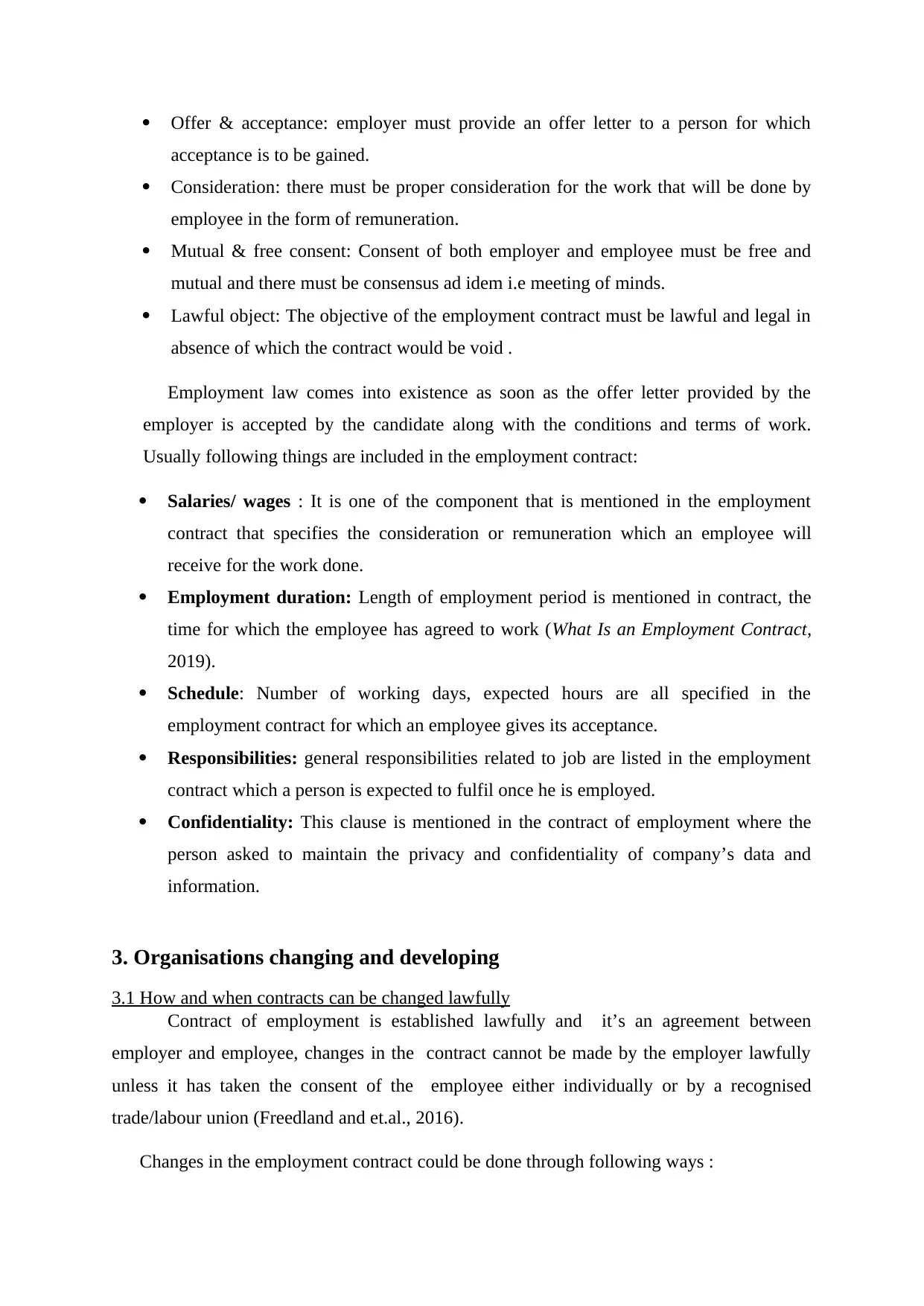
Offer & acceptance: employer must provide an offer letter to a person for which
acceptance is to be gained.
Consideration: there must be proper consideration for the work that will be done by
employee in the form of remuneration.
Mutual & free consent: Consent of both employer and employee must be free and
mutual and there must be consensus ad idem i.e meeting of minds.
Lawful object: The objective of the employment contract must be lawful and legal in
absence of which the contract would be void .
Employment law comes into existence as soon as the offer letter provided by the
employer is accepted by the candidate along with the conditions and terms of work.
Usually following things are included in the employment contract:
Salaries/ wages : It is one of the component that is mentioned in the employment
contract that specifies the consideration or remuneration which an employee will
receive for the work done.
Employment duration: Length of employment period is mentioned in contract, the
time for which the employee has agreed to work (What Is an Employment Contract,
2019).
Schedule: Number of working days, expected hours are all specified in the
employment contract for which an employee gives its acceptance.
Responsibilities: general responsibilities related to job are listed in the employment
contract which a person is expected to fulfil once he is employed.
Confidentiality: This clause is mentioned in the contract of employment where the
person asked to maintain the privacy and confidentiality of company’s data and
information.
3. Organisations changing and developing
3.1 How and when contracts can be changed lawfully
Contract of employment is established lawfully and it’s an agreement between
employer and employee, changes in the contract cannot be made by the employer lawfully
unless it has taken the consent of the employee either individually or by a recognised
trade/labour union (Freedland and et.al., 2016).
Changes in the employment contract could be done through following ways :
acceptance is to be gained.
Consideration: there must be proper consideration for the work that will be done by
employee in the form of remuneration.
Mutual & free consent: Consent of both employer and employee must be free and
mutual and there must be consensus ad idem i.e meeting of minds.
Lawful object: The objective of the employment contract must be lawful and legal in
absence of which the contract would be void .
Employment law comes into existence as soon as the offer letter provided by the
employer is accepted by the candidate along with the conditions and terms of work.
Usually following things are included in the employment contract:
Salaries/ wages : It is one of the component that is mentioned in the employment
contract that specifies the consideration or remuneration which an employee will
receive for the work done.
Employment duration: Length of employment period is mentioned in contract, the
time for which the employee has agreed to work (What Is an Employment Contract,
2019).
Schedule: Number of working days, expected hours are all specified in the
employment contract for which an employee gives its acceptance.
Responsibilities: general responsibilities related to job are listed in the employment
contract which a person is expected to fulfil once he is employed.
Confidentiality: This clause is mentioned in the contract of employment where the
person asked to maintain the privacy and confidentiality of company’s data and
information.
3. Organisations changing and developing
3.1 How and when contracts can be changed lawfully
Contract of employment is established lawfully and it’s an agreement between
employer and employee, changes in the contract cannot be made by the employer lawfully
unless it has taken the consent of the employee either individually or by a recognised
trade/labour union (Freedland and et.al., 2016).
Changes in the employment contract could be done through following ways :
Paraphrase This Document
Need a fresh take? Get an instant paraphrase of this document with our AI Paraphraser

Agreement: Employer can make agreement with employee regarding the proposed
changes which it wants to make and it should obtain the acceptance for the same from
the employee.
Collective bargaining: This is the way in which the employer negotiates with the
trade union regarding the intended changes and if there is proper consent from such
union and associations, employer can lawfully change the employment contract.
Implication: this means change in the long following customs, traditions and practise
(Changes to employment conditions, 2019).
Reasons for change:
Employer’s reasons:
Reorganisation of business
Location of the workplace
Working schedules for meeting business requirements (Blyton and Morris, 2017)
Pay rates
Employee’s reasons:
Flexible working hours
More pay
Changes in holiday/leave structure
Enhanced working conditions
Part time work
3.2 Main requirements of redundancy law
Employment Rights Act 1996 is one of the British parliamentary act that governs the
major areas of employee – employer relations. It includes leaves, training, termination, wages
and other payments. Redundancy law in the country protects the interest of employee when
they are terminated from their jobs (Golden, 2015).
Major requirements of redundancy law:
Redundancy pay : Employee is entitled for this pay when it has worked for employer for
more than 2 years or more. There are exception to this rule:
When the employer has offered you an alternative service which employee has
refused to accepted without any reasonable grounds.
changes which it wants to make and it should obtain the acceptance for the same from
the employee.
Collective bargaining: This is the way in which the employer negotiates with the
trade union regarding the intended changes and if there is proper consent from such
union and associations, employer can lawfully change the employment contract.
Implication: this means change in the long following customs, traditions and practise
(Changes to employment conditions, 2019).
Reasons for change:
Employer’s reasons:
Reorganisation of business
Location of the workplace
Working schedules for meeting business requirements (Blyton and Morris, 2017)
Pay rates
Employee’s reasons:
Flexible working hours
More pay
Changes in holiday/leave structure
Enhanced working conditions
Part time work
3.2 Main requirements of redundancy law
Employment Rights Act 1996 is one of the British parliamentary act that governs the
major areas of employee – employer relations. It includes leaves, training, termination, wages
and other payments. Redundancy law in the country protects the interest of employee when
they are terminated from their jobs (Golden, 2015).
Major requirements of redundancy law:
Redundancy pay : Employee is entitled for this pay when it has worked for employer for
more than 2 years or more. There are exception to this rule:
When the employer has offered you an alternative service which employee has
refused to accepted without any reasonable grounds.
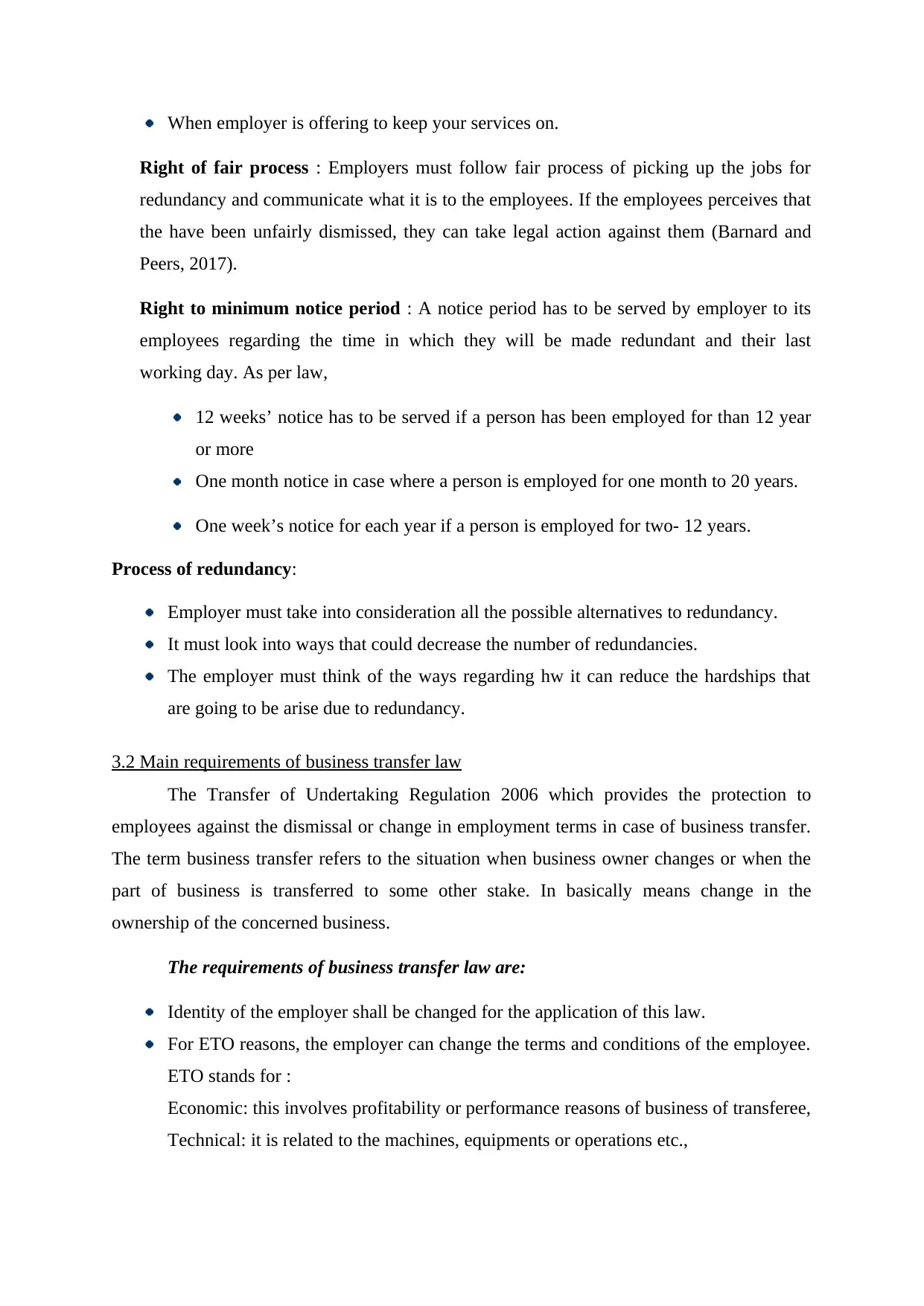
When employer is offering to keep your services on.
Right of fair process : Employers must follow fair process of picking up the jobs for
redundancy and communicate what it is to the employees. If the employees perceives that
the have been unfairly dismissed, they can take legal action against them (Barnard and
Peers, 2017).
Right to minimum notice period : A notice period has to be served by employer to its
employees regarding the time in which they will be made redundant and their last
working day. As per law,
12 weeks’ notice has to be served if a person has been employed for than 12 year
or more
One month notice in case where a person is employed for one month to 20 years.
One week’s notice for each year if a person is employed for two- 12 years.
Process of redundancy:
Employer must take into consideration all the possible alternatives to redundancy.
It must look into ways that could decrease the number of redundancies.
The employer must think of the ways regarding hw it can reduce the hardships that
are going to be arise due to redundancy.
3.2 Main requirements of business transfer law
The Transfer of Undertaking Regulation 2006 which provides the protection to
employees against the dismissal or change in employment terms in case of business transfer.
The term business transfer refers to the situation when business owner changes or when the
part of business is transferred to some other stake. In basically means change in the
ownership of the concerned business.
The requirements of business transfer law are:
Identity of the employer shall be changed for the application of this law.
For ETO reasons, the employer can change the terms and conditions of the employee.
ETO stands for :
Economic: this involves profitability or performance reasons of business of transferee,
Technical: it is related to the machines, equipments or operations etc.,
Right of fair process : Employers must follow fair process of picking up the jobs for
redundancy and communicate what it is to the employees. If the employees perceives that
the have been unfairly dismissed, they can take legal action against them (Barnard and
Peers, 2017).
Right to minimum notice period : A notice period has to be served by employer to its
employees regarding the time in which they will be made redundant and their last
working day. As per law,
12 weeks’ notice has to be served if a person has been employed for than 12 year
or more
One month notice in case where a person is employed for one month to 20 years.
One week’s notice for each year if a person is employed for two- 12 years.
Process of redundancy:
Employer must take into consideration all the possible alternatives to redundancy.
It must look into ways that could decrease the number of redundancies.
The employer must think of the ways regarding hw it can reduce the hardships that
are going to be arise due to redundancy.
3.2 Main requirements of business transfer law
The Transfer of Undertaking Regulation 2006 which provides the protection to
employees against the dismissal or change in employment terms in case of business transfer.
The term business transfer refers to the situation when business owner changes or when the
part of business is transferred to some other stake. In basically means change in the
ownership of the concerned business.
The requirements of business transfer law are:
Identity of the employer shall be changed for the application of this law.
For ETO reasons, the employer can change the terms and conditions of the employee.
ETO stands for :
Economic: this involves profitability or performance reasons of business of transferee,
Technical: it is related to the machines, equipments or operations etc.,
⊘ This is a preview!⊘
Do you want full access?
Subscribe today to unlock all pages.

Trusted by 1+ million students worldwide
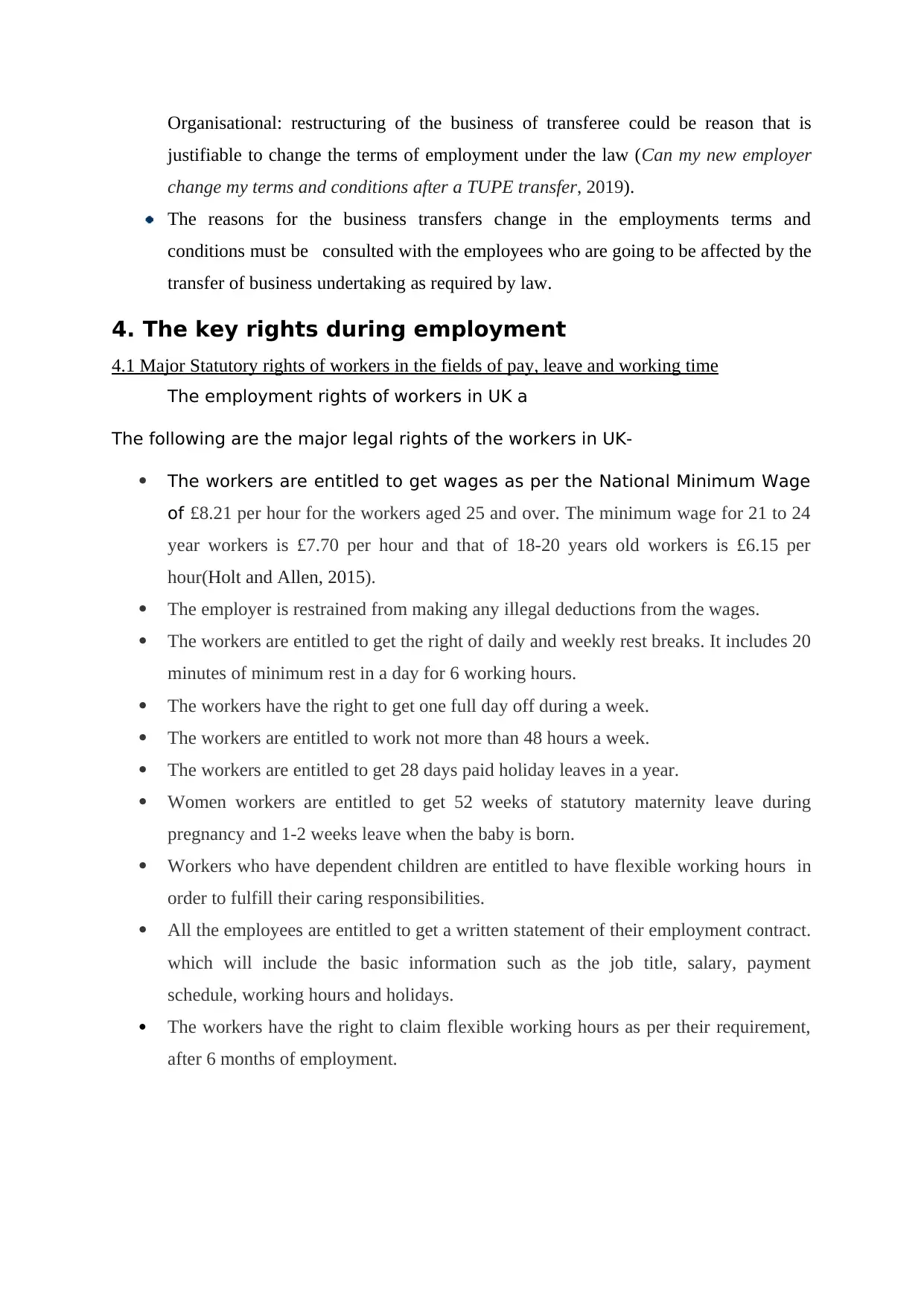
Organisational: restructuring of the business of transferee could be reason that is
justifiable to change the terms of employment under the law (Can my new employer
change my terms and conditions after a TUPE transfer, 2019).
The reasons for the business transfers change in the employments terms and
conditions must be consulted with the employees who are going to be affected by the
transfer of business undertaking as required by law.
4. The key rights during employment
4.1 Major Statutory rights of workers in the fields of pay, leave and working time
The employment rights of workers in UK a
The following are the major legal rights of the workers in UK-
The workers are entitled to get wages as per the National Minimum Wage
of £8.21 per hour for the workers aged 25 and over. The minimum wage for 21 to 24
year workers is £7.70 per hour and that of 18-20 years old workers is £6.15 per
hour(Holt and Allen, 2015).
The employer is restrained from making any illegal deductions from the wages.
The workers are entitled to get the right of daily and weekly rest breaks. It includes 20
minutes of minimum rest in a day for 6 working hours.
The workers have the right to get one full day off during a week.
The workers are entitled to work not more than 48 hours a week.
The workers are entitled to get 28 days paid holiday leaves in a year.
Women workers are entitled to get 52 weeks of statutory maternity leave during
pregnancy and 1-2 weeks leave when the baby is born.
Workers who have dependent children are entitled to have flexible working hours in
order to fulfill their caring responsibilities.
All the employees are entitled to get a written statement of their employment contract.
which will include the basic information such as the job title, salary, payment
schedule, working hours and holidays.
The workers have the right to claim flexible working hours as per their requirement,
after 6 months of employment.
justifiable to change the terms of employment under the law (Can my new employer
change my terms and conditions after a TUPE transfer, 2019).
The reasons for the business transfers change in the employments terms and
conditions must be consulted with the employees who are going to be affected by the
transfer of business undertaking as required by law.
4. The key rights during employment
4.1 Major Statutory rights of workers in the fields of pay, leave and working time
The employment rights of workers in UK a
The following are the major legal rights of the workers in UK-
The workers are entitled to get wages as per the National Minimum Wage
of £8.21 per hour for the workers aged 25 and over. The minimum wage for 21 to 24
year workers is £7.70 per hour and that of 18-20 years old workers is £6.15 per
hour(Holt and Allen, 2015).
The employer is restrained from making any illegal deductions from the wages.
The workers are entitled to get the right of daily and weekly rest breaks. It includes 20
minutes of minimum rest in a day for 6 working hours.
The workers have the right to get one full day off during a week.
The workers are entitled to work not more than 48 hours a week.
The workers are entitled to get 28 days paid holiday leaves in a year.
Women workers are entitled to get 52 weeks of statutory maternity leave during
pregnancy and 1-2 weeks leave when the baby is born.
Workers who have dependent children are entitled to have flexible working hours in
order to fulfill their caring responsibilities.
All the employees are entitled to get a written statement of their employment contract.
which will include the basic information such as the job title, salary, payment
schedule, working hours and holidays.
The workers have the right to claim flexible working hours as per their requirement,
after 6 months of employment.
Paraphrase This Document
Need a fresh take? Get an instant paraphrase of this document with our AI Paraphraser
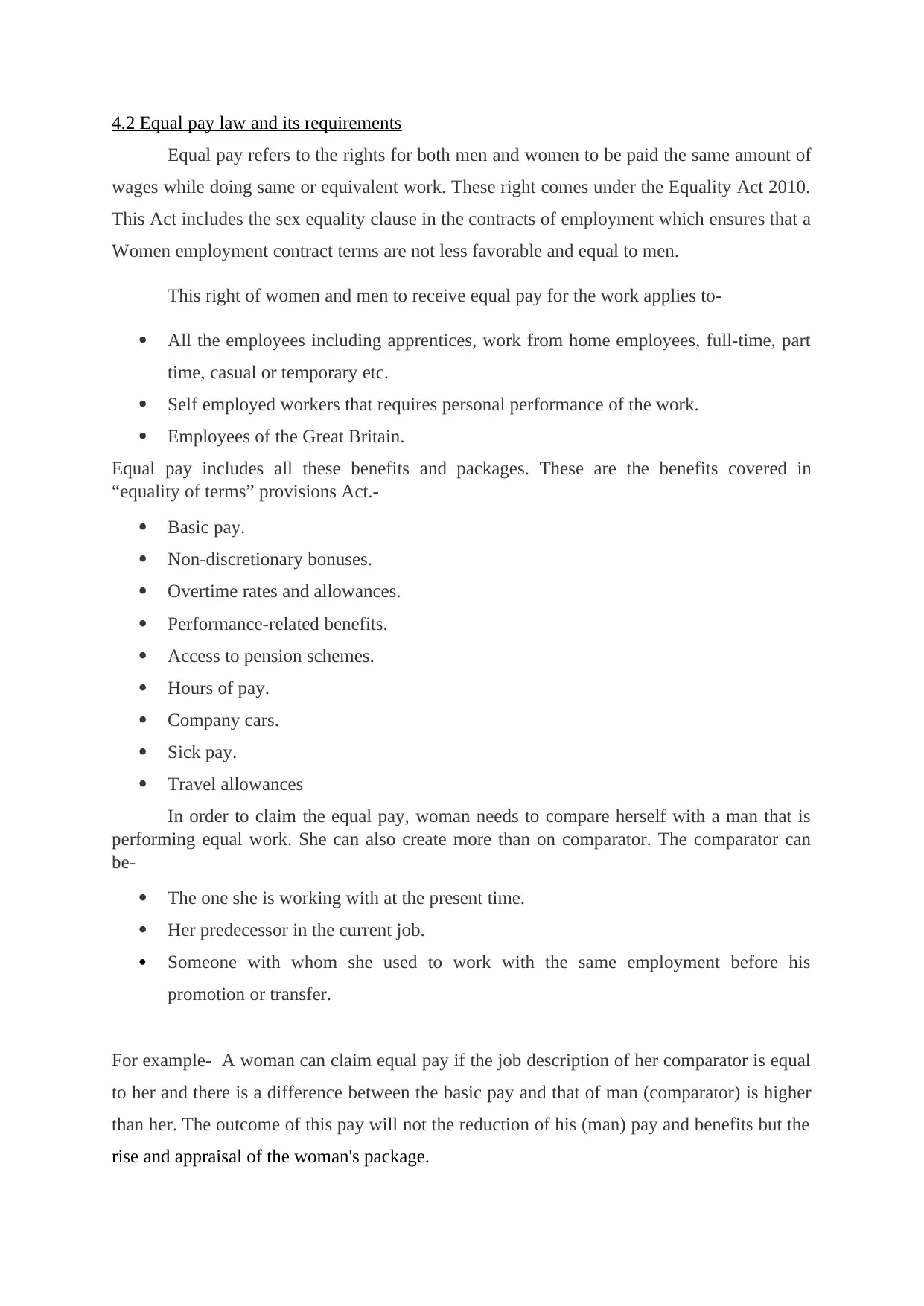
4.2 Equal pay law and its requirements
Equal pay refers to the rights for both men and women to be paid the same amount of
wages while doing same or equivalent work. These right comes under the Equality Act 2010.
This Act includes the sex equality clause in the contracts of employment which ensures that a
Women employment contract terms are not less favorable and equal to men.
This right of women and men to receive equal pay for the work applies to-
All the employees including apprentices, work from home employees, full-time, part
time, casual or temporary etc.
Self employed workers that requires personal performance of the work.
Employees of the Great Britain.
Equal pay includes all these benefits and packages. These are the benefits covered in
“equality of terms” provisions Act.-
Basic pay.
Non-discretionary bonuses.
Overtime rates and allowances.
Performance-related benefits.
Access to pension schemes.
Hours of pay.
Company cars.
Sick pay.
Travel allowances
In order to claim the equal pay, woman needs to compare herself with a man that is
performing equal work. She can also create more than on comparator. The comparator can
be-
The one she is working with at the present time.
Her predecessor in the current job.
Someone with whom she used to work with the same employment before his
promotion or transfer.
For example- A woman can claim equal pay if the job description of her comparator is equal
to her and there is a difference between the basic pay and that of man (comparator) is higher
than her. The outcome of this pay will not the reduction of his (man) pay and benefits but the
rise and appraisal of the woman's package.
Equal pay refers to the rights for both men and women to be paid the same amount of
wages while doing same or equivalent work. These right comes under the Equality Act 2010.
This Act includes the sex equality clause in the contracts of employment which ensures that a
Women employment contract terms are not less favorable and equal to men.
This right of women and men to receive equal pay for the work applies to-
All the employees including apprentices, work from home employees, full-time, part
time, casual or temporary etc.
Self employed workers that requires personal performance of the work.
Employees of the Great Britain.
Equal pay includes all these benefits and packages. These are the benefits covered in
“equality of terms” provisions Act.-
Basic pay.
Non-discretionary bonuses.
Overtime rates and allowances.
Performance-related benefits.
Access to pension schemes.
Hours of pay.
Company cars.
Sick pay.
Travel allowances
In order to claim the equal pay, woman needs to compare herself with a man that is
performing equal work. She can also create more than on comparator. The comparator can
be-
The one she is working with at the present time.
Her predecessor in the current job.
Someone with whom she used to work with the same employment before his
promotion or transfer.
For example- A woman can claim equal pay if the job description of her comparator is equal
to her and there is a difference between the basic pay and that of man (comparator) is higher
than her. The outcome of this pay will not the reduction of his (man) pay and benefits but the
rise and appraisal of the woman's package.
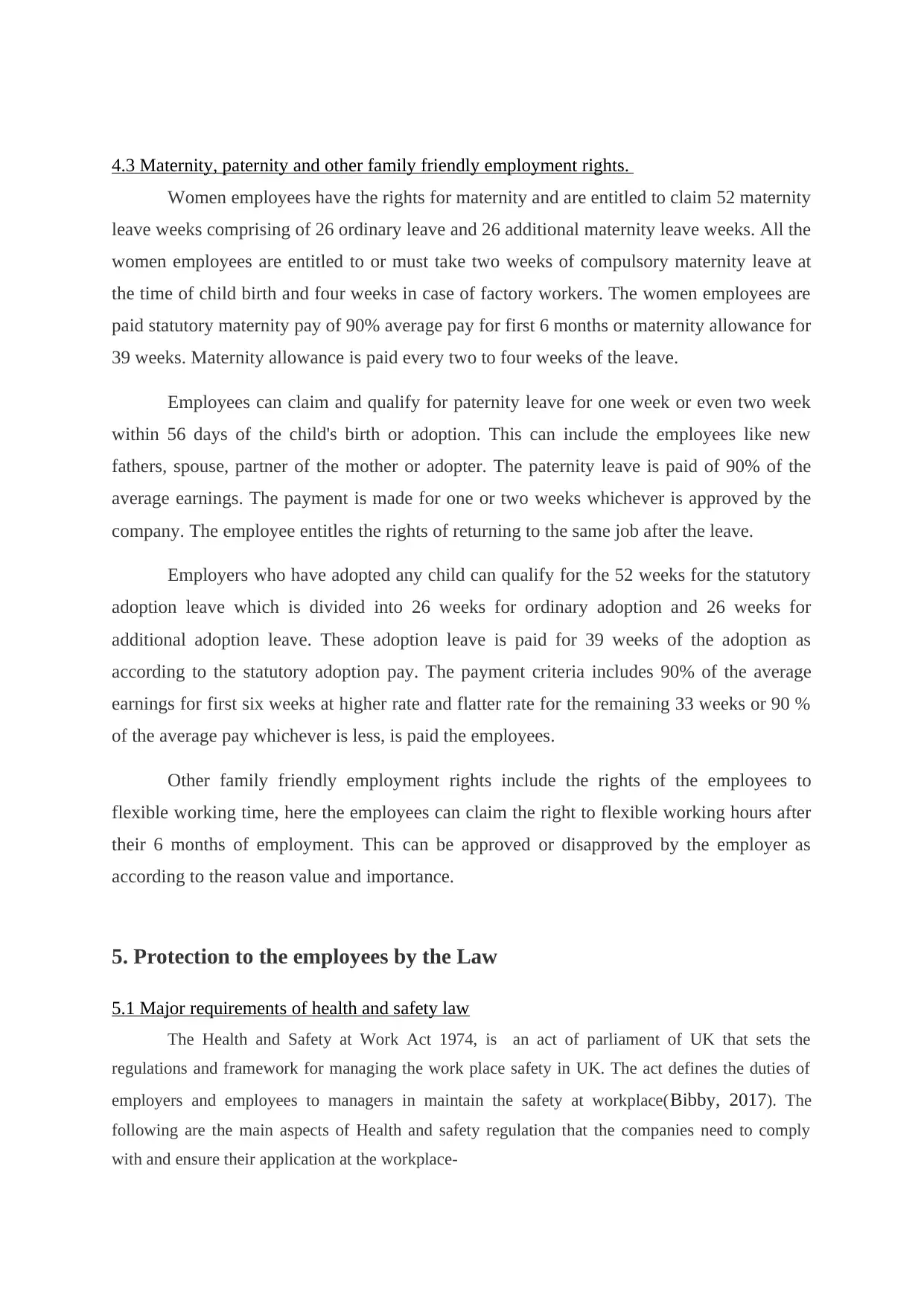
4.3 Maternity, paternity and other family friendly employment rights.
Women employees have the rights for maternity and are entitled to claim 52 maternity
leave weeks comprising of 26 ordinary leave and 26 additional maternity leave weeks. All the
women employees are entitled to or must take two weeks of compulsory maternity leave at
the time of child birth and four weeks in case of factory workers. The women employees are
paid statutory maternity pay of 90% average pay for first 6 months or maternity allowance for
39 weeks. Maternity allowance is paid every two to four weeks of the leave.
Employees can claim and qualify for paternity leave for one week or even two week
within 56 days of the child's birth or adoption. This can include the employees like new
fathers, spouse, partner of the mother or adopter. The paternity leave is paid of 90% of the
average earnings. The payment is made for one or two weeks whichever is approved by the
company. The employee entitles the rights of returning to the same job after the leave.
Employers who have adopted any child can qualify for the 52 weeks for the statutory
adoption leave which is divided into 26 weeks for ordinary adoption and 26 weeks for
additional adoption leave. These adoption leave is paid for 39 weeks of the adoption as
according to the statutory adoption pay. The payment criteria includes 90% of the average
earnings for first six weeks at higher rate and flatter rate for the remaining 33 weeks or 90 %
of the average pay whichever is less, is paid the employees.
Other family friendly employment rights include the rights of the employees to
flexible working time, here the employees can claim the right to flexible working hours after
their 6 months of employment. This can be approved or disapproved by the employer as
according to the reason value and importance.
5. Protection to the employees by the Law
5.1 Major requirements of health and safety law
The Health and Safety at Work Act 1974, is an act of parliament of UK that sets the
regulations and framework for managing the work place safety in UK. The act defines the duties of
employers and employees to managers in maintain the safety at workplace(Bibby, 2017). The
following are the main aspects of Health and safety regulation that the companies need to comply
with and ensure their application at the workplace-
Women employees have the rights for maternity and are entitled to claim 52 maternity
leave weeks comprising of 26 ordinary leave and 26 additional maternity leave weeks. All the
women employees are entitled to or must take two weeks of compulsory maternity leave at
the time of child birth and four weeks in case of factory workers. The women employees are
paid statutory maternity pay of 90% average pay for first 6 months or maternity allowance for
39 weeks. Maternity allowance is paid every two to four weeks of the leave.
Employees can claim and qualify for paternity leave for one week or even two week
within 56 days of the child's birth or adoption. This can include the employees like new
fathers, spouse, partner of the mother or adopter. The paternity leave is paid of 90% of the
average earnings. The payment is made for one or two weeks whichever is approved by the
company. The employee entitles the rights of returning to the same job after the leave.
Employers who have adopted any child can qualify for the 52 weeks for the statutory
adoption leave which is divided into 26 weeks for ordinary adoption and 26 weeks for
additional adoption leave. These adoption leave is paid for 39 weeks of the adoption as
according to the statutory adoption pay. The payment criteria includes 90% of the average
earnings for first six weeks at higher rate and flatter rate for the remaining 33 weeks or 90 %
of the average pay whichever is less, is paid the employees.
Other family friendly employment rights include the rights of the employees to
flexible working time, here the employees can claim the right to flexible working hours after
their 6 months of employment. This can be approved or disapproved by the employer as
according to the reason value and importance.
5. Protection to the employees by the Law
5.1 Major requirements of health and safety law
The Health and Safety at Work Act 1974, is an act of parliament of UK that sets the
regulations and framework for managing the work place safety in UK. The act defines the duties of
employers and employees to managers in maintain the safety at workplace(Bibby, 2017). The
following are the main aspects of Health and safety regulation that the companies need to comply
with and ensure their application at the workplace-
⊘ This is a preview!⊘
Do you want full access?
Subscribe today to unlock all pages.

Trusted by 1+ million students worldwide
1 out of 19
Related Documents
Your All-in-One AI-Powered Toolkit for Academic Success.
+13062052269
info@desklib.com
Available 24*7 on WhatsApp / Email
![[object Object]](/_next/static/media/star-bottom.7253800d.svg)
Unlock your academic potential
Copyright © 2020–2025 A2Z Services. All Rights Reserved. Developed and managed by ZUCOL.





